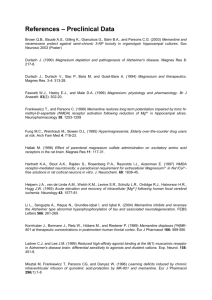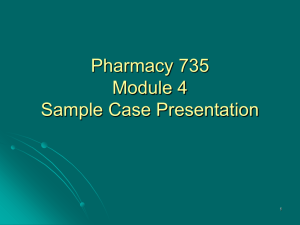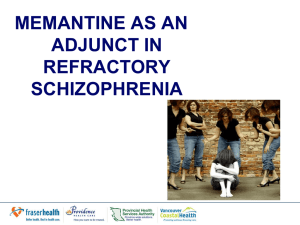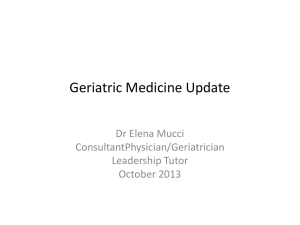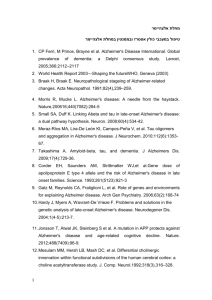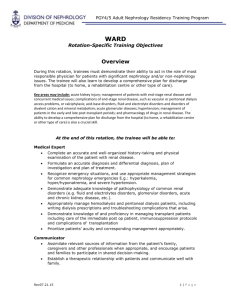Data Sheet
advertisement
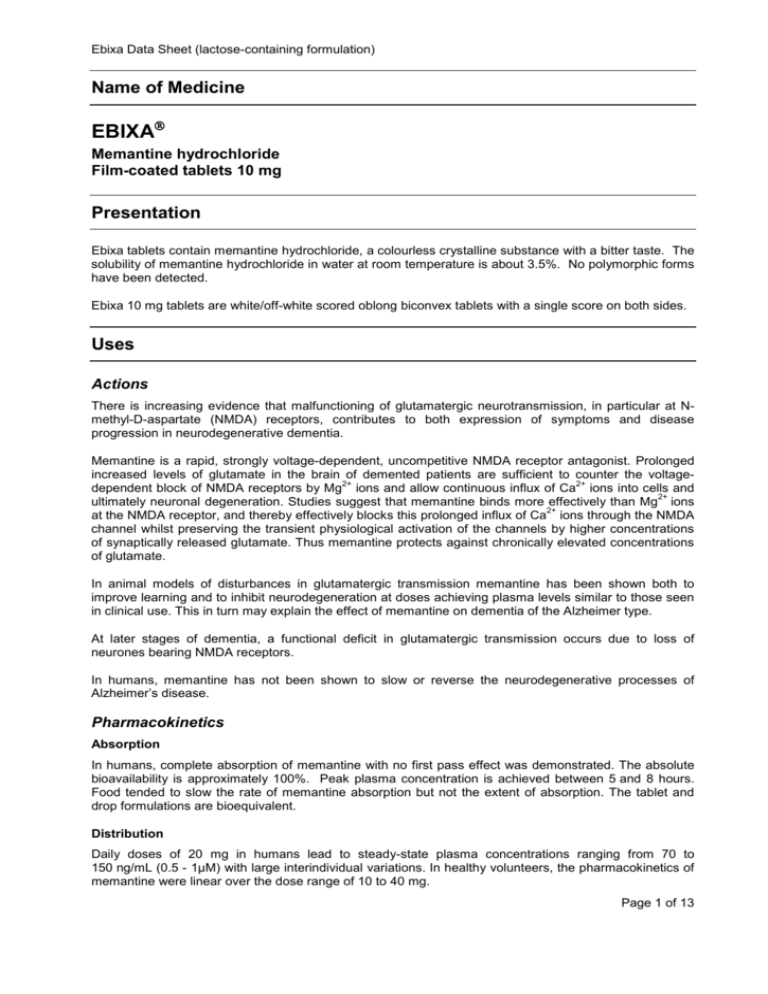
Ebixa Data Sheet (lactose-containing formulation) Name of Medicine EBIXA Memantine hydrochloride Film-coated tablets 10 mg Presentation Ebixa tablets contain memantine hydrochloride, a colourless crystalline substance with a bitter taste. The solubility of memantine hydrochloride in water at room temperature is about 3.5%. No polymorphic forms have been detected. Ebixa 10 mg tablets are white/off-white scored oblong biconvex tablets with a single score on both sides. Uses Actions There is increasing evidence that malfunctioning of glutamatergic neurotransmission, in particular at Nmethyl-D-aspartate (NMDA) receptors, contributes to both expression of symptoms and disease progression in neurodegenerative dementia. Memantine is a rapid, strongly voltage-dependent, uncompetitive NMDA receptor antagonist. Prolonged increased levels of glutamate in the brain of demented patients are sufficient to counter the voltage2+ 2+ dependent block of NMDA receptors by Mg ions and allow continuous influx of Ca ions into cells and 2+ ultimately neuronal degeneration. Studies suggest that memantine binds more effectively than Mg ions 2+ at the NMDA receptor, and thereby effectively blocks this prolonged influx of Ca ions through the NMDA channel whilst preserving the transient physiological activation of the channels by higher concentrations of synaptically released glutamate. Thus memantine protects against chronically elevated concentrations of glutamate. In animal models of disturbances in glutamatergic transmission memantine has been shown both to improve learning and to inhibit neurodegeneration at doses achieving plasma levels similar to those seen in clinical use. This in turn may explain the effect of memantine on dementia of the Alzheimer type. At later stages of dementia, a functional deficit in glutamatergic transmission occurs due to loss of neurones bearing NMDA receptors. In humans, memantine has not been shown to slow or reverse the neurodegenerative processes of Alzheimer’s disease. Pharmacokinetics Absorption In humans, complete absorption of memantine with no first pass effect was demonstrated. The absolute bioavailability is approximately 100%. Peak plasma concentration is achieved between 5 and 8 hours. Food tended to slow the rate of memantine absorption but not the extent of absorption. The tablet and drop formulations are bioequivalent. Distribution Daily doses of 20 mg in humans lead to steady-state plasma concentrations ranging from 70 to 150 ng/mL (0.5 - 1µM) with large interindividual variations. In healthy volunteers, the pharmacokinetics of memantine were linear over the dose range of 10 to 40 mg. Page 1 of 13 Ebixa Data Sheet (lactose-containing formulation) When daily doses of 5 to 30 mg were administered, a mean cerebrospinal fluid (CSF)/serum ratio of 0.52 was obtained. The inhibition constant (k i ) of memantine at its site of action in human frontal cortex has been determined to be 0.5 µM. In subjects receiving a daily dose of 2 x 10 mg steady-state plasma levels were reached around day 11 and varied between 0.5 and 1.0 µM, which leads to CSF levels close to the k i of memantine. The volume of distribution is approximately 10 L/kg. Protein binding in humans varied from 42% to 54% and no relationship was observed between plasma memantine concentration and protein binding. Biotransformation In humans, memantine is excreted mainly (60 - 80%) in its unchanged form in urine. Human metabolites are 1-amino-3-hydroxymethyl-5-methyl-adamantane, 3-amino-1-hydroxy-5,7-dimethyl-adamantane and various secondary hydroxylated not yet definitively identified memantine-derivatives; phase II metabolism amounts for up to 10%. The known metabolites do not have any NMDA-antagonistic activity. In view of the minor degree of metabolism, variation with respect to polymorphic metabolism is not anticipated. In vitro experiments have indicated that memantine is not metabolised by CYP isoenzymes 1A2, 2A6, 2B6, 2C9, 2C19, 2D6, 2E1 and 3A4. Elimination Memantine is eliminated predominantly by the kidneys in a monoexponential manner with a terminal halflife of 60 to 100 h. In volunteers with normal kidney function, systemic clearance amounts to 170 mL/min. 14 In a study on the absorption, metabolism and excretion of orally administered C-memantine, a mean of 84% of the dose was recovered within 20 days, the majority being excreted unchanged renally. Renal clearance has been shown to depend on the pH of the urine. Under alkaline conditions the renal clearance of unchanged memantine is markedly reduced compared to neutral or acidic urine conditions. This is presumably due to tubular reabsorption of memantine under alkaline conditions. Reduced hepatic function In patients with mild or moderate hepatic impairment (Child-Pugh A and Child-Pugh B), no dosage adjustment is required. No data is available for patients with severe hepatic impairment (see DOSAGE AND ADMINISTRATION). Administration of Ebixa is not recommended in patients with severe hepatic impairment. Reduced renal function In elderly volunteers with impaired renal function (creatinine clearance down to about 50 mL/min), a significant correlation was observed between creatinine clearance and total renal clearance of memantine. Total renal clearance substantially exceeded renal clearance by filtration thus indicating that a significant part of renal clearance is due to tubular secretion processes. In patients with mildly impaired renal function (creatinine clearance 50 - 80 mL/min), no dosage adjustment is required. A reduction in dosage is advised for patients with moderate to severe renal impairment (see DOSAGE AND ADMINISTRATION). Clinical trials A pivotal study of memantine in the treatment of mild to moderate Alzheimer’s disease (MMSE total scores at baseline of 10 to 22) included 403 patients. Memantine was associated with statistically significantly better efficacy than placebo on the primary endpoints: ADAS-cog (p=0.003) and CIBIC-plus (p=0.004) at week 24 (LOCF). A pivotal 6 month multicentre, double-blind, randomised, placebo-controlled study conducted in a population of patients with moderately severe to severe Alzheimer’s disease (MMSE 3 - 14) included a total of 252 outpatients of Asian American, African American and Caucasian background (33% male, 67% female, mean age 76 years). The dosing was 10 mg memantine b.i.d. Outcomes included assessment of the cognitive domain (using the Severe Impairment Battery (SIB)), the global domain (using the Clinicians Interview-Based Impression of Change (CIBIC-Plus)) and the Page 2 of 13 Ebixa Data Sheet (lactose-containing formulation) functional domain (using the modified Alzheimer’s Disease Cooperative Study – Activities of Daily Living Inventory (ADCS-ADL)). The efficacy results described are from the ITT dataset (all randomised patients) with the LOCF method (last observation carried forward) as well as the OC (observed cases). Based on the OC analyses, the results of this study met the requirement of the European Union Guideline CPMP/EWP/553/95 for statistically significant reduction in deterioration in the functional and global endpoints as primary evidence of clinically relevant symptomatic reduction in deterioration in more advanced forms of Alzheimer’s disease. An overview of the results in the most important domains of efficacy is displayed in Table 1. Table 1: Efficacy results of a 6 month study in patients suffering from Alzheimer´s disease ITT-LOCF Analysis Domain Cognition: SIB (score range 0-100) Function: ADCS-ADL sev. (score range 0-54) Global: CIBIC-plus (score range 1-7) Placebo (n=126) Memantine (n=126) - 9.84 -3.93 (SD 13.43) (SD 11.26) - 5.08 -3.02 (SD 6.30) (SD 6.75) 4.73 4.48 (SD 1.07) (SD 1.09) ITT-OC Analysis Mean difference p value 5.91 <0.001 2.06 0.022 0.25 0.064 Placebo (n=84) Memantine (n=97) -10.16 -4.46 (SD 12.66) (SD 11.48) -5.86 -2.49 (SD 6.78) (SD 6.27) 4.74 4.38 (SD 1.13) (SD 1.12) Mean difference p value 5.7 0.002 3.37 0.003 0.36 0.025 Memantine was very well tolerated with similar frequency and type of adverse events observed with memantine compared with placebo. A pivotal 3 month multicentre, double-blind, randomised, placebo-controlled study was conducted in Caucasian patients with moderately severe to severe Alzheimer’s disease or vascular dementia (MMSE < 10). In this study a total of 79 nursing home residents (33% male, 67% female, mean age 74 years) had Alzheimer’s disease. The dosing used was 10 mg memantine daily. Outcomes included assessment of the cognitive domain (using the cognitive subscore of the rating scale for geriatric patients (BGP)), the global domain (using the Clinical Global Impression of Change (CGI-C)) and the functional domain (using the subscore care dependency of the BGP). Despite the small sample size, the results in all of these three domains were statistically significant in favour of memantine (see Table 2). The efficacy results described are from the ITT dataset (all randomised patients) with the LOCF method (last observation carried forward) as well as OC (observed cases). Table 2: Efficacy results for a 3 month study in patients suffering from Alzheimer’s disease ITT-LOCF Analysis Domain ITT-OC Analysis Placebo (n=38) Memantine (n=41) Mean difference p value Placebo (n=37) Memantine (n=39) Mean difference p value BGP cognitive (score range 0-10) -1.03 -2.00 0.97 0.007 -1.05 -2.10 1.05 0.004 BGP functional (score range 0-46) -2.79 -5.76 2.97 0.003 -2.89 -6.05 3.16 0.002 CGI-C 3.47 3.15 0.32 0.002 3.46 3.08 0.38 0.005 Page 3 of 13 Ebixa Data Sheet (lactose-containing formulation) (score range 1-7) Memantine was well tolerated, with physicians rating tolerability as ‘very good’ in 71% of memantine and 69% of placebo treated patients. In the remaining patients tolerability was assessed as ‘good’, with the exception of one memantine treated patient where it was assessed as ‘moderate’. The efficacy results for moderate to severe Alzheimer’s disease consist of meta-analyses and pooled analyses of the data from six placebo-controlled, 6 month studies considering those patients who had a baseline MMSE score < 20. Three studies were conducted in mild to moderate Alzheimer’s disease and three in moderate to severe Alzheimer’s disease. The population with moderate to severe Alzheimer’s disease consisted of a total of 1826 patients; 867 treated with placebo and 959 treated with memantine. Meta-analyses Meta-analyses of the efficacy endpoints were performed on the patients with moderate to severe Alzheimer’s disease. For the cognitive, global, and functional endpoints, there was a statistically significant effect in favour of memantine treatment (p<0.01). Standardised effect sizes (OC) were 0.26 for the cognitive domain, 0.22 for the global domain, and 0.18 for the functional domain. The LOCF results were also positive and consistent with the OC results. Analyses of prevention of clinical worsening Clinically relevant analyses based on the prevention of worsening of clinical symptoms (defined as a ≥ 4point decline on the ADAS-cog or ≥ 5-point decline on the SIB and a decline on the CIBIC-plus and a decline on the ADCS-ADL) in the population of patients with moderate to severe Alzheimer’s disease showed that over the course of the 6 months of treatment, approximately twice as many placebo-treated patients than memantine-treated patients worsened (21% vs 11%; OC; p<0.001). For the subgroup of patients with MMSE scores between 10 and 19, who represent patients with moderate Alzheimer’s disease, approximately twice as many placebo-treated patients as memantine-treated patients worsened (16% vs 9%; OC; p<0.001). The LOCF analyses showed similar results as those using OC, and were statistically significantly in favour of memantine treatment. Pooled analyses Analysis of NPI total scores in the population of patients with moderate to severe Alzheimer’s disease showed a statistically significant benefit of memantine compared to placebo at week 12 (OC; p=0.001) and week 24 (OC; p=0.035; LOCF; p=0.008). Analysis of NPI single items in the population of patients with moderate to severe Alzheimer’s disease showed statistically superior effects of memantine compared to placebo at week 12 on the items Delusions, Hallucinations, and Agitation/Aggression (p<0.05; LOCF). At week 12, placebo-treated patients worsened on 11 of the 12 NPI single items, while memantine-treated patients improved on 10 of the 12 items. At week 24/28 the items Delusions, Agitation/Aggression and Irritability/Lability were statistically significantly in favour of memantine compared to placebo (p<0.01; LOCF). Individual NPI single items were analysed in the subset of patients who were symptomatic for the NPI items at baseline. Statistically significantly more memantine-treated patients than placebo-treated patients showed improvement at week 24 on Delusions, Agitation/Aggression and Disinhibition. Individual NPI single items were analysed in the subset of patients who were asymptomatic for the individual NPI items at baseline. Statistically significantly more memantine-treated patients than placebotreated patients remained asymptomatic at week 24 on Agitation/Aggression, Irritability/Lability and Nighttime Behaviour. Indications Treatment of the symptoms of moderate to severe Alzheimer's disease (see Uses; Warnings and Precautions). Dosage and Administration Page 4 of 13 Ebixa Data Sheet (lactose-containing formulation) The tolerance and dosing of memantine should be reassessed on a regular basis, preferably within three months after start of treatment. Thereafter, the clinical benefit of memantine and the patient’s tolerance of treatment should be reassessed on a regular basis according to current clinical guidelines. Maintenance treatment can be continued for as long as a therapeutic benefit is favourable and the patient tolerates treatment with memantine. Discontinuation of memantine should be considered when evidence of a therapeutic effect is no longer present or if the patient does not tolerate treatment. Adults The recommended maintenance dose is 20 mg (2 x 10 mg tablet) once a day, at the same time every day. This is achieved by upward titration as follows: st nd Treatment should be started with 5 mg (half a tablet) daily during the 1 week. In the 2 week the dose is rd 10 mg daily (one tablet) and in the 3 week 15 mg/day (one and a half tablets per day) is recommended. th From the 4 week on, treatment is usually continued with the maintenance dose of 20 mg/day (two tablets per day.). Tablets should be swallowed with a little liquid. They can be taken with or without food. Children The use of Ebixa in children is not recommended. Hepatic impairment In patients with mild or moderate hepatic impairment (Child-Pugh A and Child-Pugh B), no dosage adjustment is required. No data on the use of memantine in patients with severe hepatic impairment is available. Administration of Ebixa is not recommended in patients with severe hepatic impairment. Renal impairment In patients with mildly impaired renal function (creatinine clearance 50 - 80 mL/min), no dosage adjustment is required. In patients with moderate renal impairment (creatinine clearance 30 - 49 mL/min), the daily dose should be 10 mg per day. If tolerated well after at least 7 days of treatment, the dose can be increased up to 20 mg/day according to the standard titration scheme. In patients with severe renal impairment (creatinine clearance 5 - 29 mL/min), the daily dose should be 10 mg per day. Contraindications Ebixa is contraindicated in patients with: • hypersensitivity to either the active ingredient or any of the excipients • patients with a current seizure disorder or with any history of seizures Warnings and Precautions Risk of seizures - Memantine is contraindicated in patients with epilepsy. Patient care - Treatment should be initiated and supervised by a physician experienced in the diagnosis and treatment of dementia. Diagnosis should be made according to current guidelines. Therapy should usually be started only when a caregiver is available who will regularly monitor patient compliance. Treatment with memantine hydrochloride should only be continued where there is a therapeutic benefit to the patient. The clinical benefit should be reassessed on a regular basis. Page 5 of 13 Ebixa Data Sheet (lactose-containing formulation) Ocular toxicity - Animal studies have reported adverse effects of memantine on the visual system. Dietary administration of memantine to rats for one year was associated with abnormal lysosomal storage in ganglion cells and retinal pigment cells at systemic exposures (plasma AUC) 10 fold anticipated clinical exposure at the recommended dose, while administration for 8 weeks was associated with lens opacity, increased corneal and lens capsular densities, and histological changes in cornea and lens at exposures (plasma AUC) of 20 fold clinical exposure. Oral administration of memantine to dogs with systemic exposures (plasma AUC) of 3 - 8 fold clinical exposure was associated with corneal clouding/opacity and baboons showed swollen lenticular fibres in the eyes following oral memantine for 3 months at less than clinical exposure. Specific ophthalmological examinations including slit lamp examinations in a 6 months clinical study with memantine did not disclose any ocular changes in the double-blind placebo-controlled treatment period. In the following 6 months open label extension period 368 patients underwent eye examinations. At the end of open label treatment, the incidence of cataract (lens previously clear but unclear at end of open label treatment) was reported in 11 out of 197 patients (6%) treated with memantine for 12 months compared to 5 out of 171 patients (3%) who received placebo in the double-blind period and then memantine for 6 months (p=0.3059, Fisher’s Exact Test). Urinary pH - Some factors that may raise urinary pH may necessitate careful monitoring of the patient. These factors include drastic changes in diet, e.g. from a meat-eating to a vegetarian diet, or a massive ingestion of alkalising gastric buffers. Also, urine pH may be elevated by states of renal tubular acidosis (RTA) or severe infections of the urinary tract with Proteus bacteria. Renal impairment - In patients with mildly impaired renal function (creatinine clearance 50 - 80 mL/min), no dosage adjustment is required. A reduction in dosage is advised for patients with moderate to severe renal impairment (see DOSAGE AND ADMINISTRATION). Hepatic impairment - In patients with mild or moderate hepatic impairment (Child-Pugh A and Child-Pugh B), no dosage adjustment is required. No data is available for patients with severe hepatic impairment (see DOSAGE AND ADMINISTRATION). Administration of Ebixa is not recommended in patients with severe hepatic impairment. Cardiovascular disease - In most clinical trials, patients with recent myocardial infarction, uncompensated congestive heart failure (NYHA III-IV), and uncontrolled hypertension were excluded. As a consequence, only limited data are available and patients with these conditions should be closely supervised. Excipients - The 10 mg tablets contain lactose monohydrate. Patients with rare hereditary problems of galactose intolerance, the Lapp lactase deficiency or glucose-galactose malabsorption should not take this medicine. Pregnancy and Lactation Category B2 There was no evidence of teratogenicity in rats following oral administration of memantine during the period of organogenesis at estimated exposures (plasma AUC) of up to 4 fold anticipated clinical exposure at the recommended dose. There was also no teratogenicity in rats following oral administration to males prior to and during mating and to females from prior to mating to late gestation or to weaning, with respective estimated systemic exposures (plasma AUC) of twice and 4 fold anticipated clinical exposure. There was no teratogenicity in rabbits following oral administration of memantine during the period of organogenesis at doses up to 25 fold the clinical dose, based on body surface area. Oral administration of memantine to rats during late gestation and lactation was associated with increased post-implantation loss and transiently reduced neonatal bodyweight at estimated systemic exposures (plasma AUC) of 4 fold anticipated clinical exposure at the recommended dose. It is not known whether memantine is excreted in animal or human milk. Because of the potential for causing toxicity, memantine should be contraindicated in nursing women. Effects on ability to drive and use machines Page 6 of 13 Ebixa Data Sheet (lactose-containing formulation) Moderate to severe Alzheimer´s disease usually causes impairment of driving performance and compromises the ability to use machinery. Furthermore, Ebixa may change reactivity and therefore outpatients should be warned to take special care when driving a vehicle or operating heavy machinery. Other Mutagenicity and carcinogenicity studies Long term dietary administration of memantine to mice (2 years) and rats (2.5 years), with respective estimated systemic exposures of 9 fold (plasma levels) and 4 - 8 fold (plasma AUC) the anticipated clinical exposure at the recommended dose, did not reveal any carcinogenic potential. Memantine did not show any genotoxic potential in assays for gene mutation (bacterial and mammalian cells in vitro) or in clastogenicity assays (human lymphocytes in vitro and mouse bone marrow in vivo). Impairment of fertility Fertility was not affected by oral administration of memantine to male and female rats prior to and during mating at doses associated with respective systemic exposures (plasma AUC) of twice and 4 fold anticipated clinical exposure at the recommended dose. Adverse Effects The following table gives an overview of the most frequent (≥ 2% for memantine) adverse events (irrespective of causal relationship) that were observed in clinical trials in Alzheimer’s disease. Placebo n=1595 (%) Memantine n=1784 (%) Accidental injury 111 (7.0) 101 (5.7) Influenza-like symptoms 63 (3.9) 74 (4.1) Fatigue 31 (1.9) 48 (2.7) Oedema peripheral 33 (2.1) 48 (2.7) Back pain 46 (2.9) 44 (2.5) Pain 20 (1.3) 37 (2.1) 42 (2.6) 71 (4.0) Dizziness 89 (5.6) 113 (6.3) Headache 62 (3.9) 92 (5.2) Gait abnormal 40 (2.5) 56 (3.1) Constipation 41 (2.6) 82 (4.6) Diarrhoea 74 (4.6) 78 (4.4) Vomiting 33 (2.1) 53 (3.0) System Organ Class & Preferred Term BODY AS A WHOLE – GENERAL DISORDERS CARDIOVASCULAR DISORDERS - GENERAL Hypertension CENTRAL & PERIPHERAL NERVOUS SYSTEM DISORDERS GASTROINTESTINAL SYSTEM DISORDERS Page 7 of 13 Ebixa Data Sheet (lactose-containing formulation) Nausea 43 (2.7) 45 (2.5) 38 (2.4) 46 (2.6) Agitation 158 (9.9) 114 (6.4) Confusion 65 (4.1) 84 (4.7) Somnolence 35 (2.2) 61 (3.4) Depression 57 (3.6) 57 (3.2) Insomnia 71 (4.5) 54 (3.0) Anxiety 38 (2.4) 47 (2.6) Anorexia 29 (1.8) 36 (2.0) Coughing 44 (2.8) 56 (3.1) Bronchitis 44 (2.8) 51 (2.9) Upper respiratory tract infection 52 (3.3) 48 (2.7) Rhinitis 28 (1.8) 36 (2.0) 99 (6.2) 99 (5.5) Urinary tract infection 66 (4.1) 63 (3.5) Urinary incontinence 55 (3.4) 60 (3.4) MUSCULOSKELETAL SYSTEM DISORDERS Arthralgia PSYCHIATRIC DISORDERS RESPIRATORY SYSTEM DISORDERS SECONDARY TERMS Fall URINARY SYSTEM DISORDERS The following adverse events were reported with memantine at a frequency between 1% and < 2% at an incidence greater than placebo: asthenia, dyspnoea, pneumonia, cardiac failure, weight decrease, weight increase, rash, transient ischaemic attack, cataract, fibrillation atrial, prostatic disorder [gs]. As in the above table, causality to memantine has not been established. Adverse events reported with memantine at a frequency between 1% and 2% that occurred at a similar rate to or less than placebo were: syncope, chest pain, fever, hallucination, delusion, aggressive reaction, faecal incontinence, tremor, abdominal pain, dyspepsia, hyperglycaemia. Although no causal relationship to Ebixa treatment has been found, the following adverse events were reported in at least one patient, either from clinical trials or spontaneous reports. All of these events, which are not listed above, either occurred rarely (< 1%) or at an unknown incidence from data originating from spontaneous reports. Alzheimer’s disease has been associated with depression, suicidal ideation and suicide. marketing experience these events have been reported in patients treated with memantine. In post- Application Site Disorders Cellulitis, otitis externa. Page 8 of 13 Ebixa Data Sheet (lactose-containing formulation) Body as a Whole - General Disorders Allergic reaction, allergy, carpal tunnel syndrome, condition aggravated, crying abnormal, diagnostic procedure, ESR increased, hernia inguinal, hernia NOS, hot flushes, laboratory value abnormal, leg pain, malaise, oedema, pallor, procedure NOS, rigors, temperature changed sensation. Cardiovascular Disorders Cardiomegaly, ECG abnormal, ECG abnormal specific, heart disorder, heart murmur, hypertension aggravated, hypotension, hypotension postural, oedema dependent, pulse weak. Central and Peripheral Nervous System Disorders Absences, aphasia, apraxia, ataxia, cognitive disorders, coma, coordination abnormal, convulsions, dementia, dyskinesia, dyskinesia tardive, encephalopathy, extrapyramidal disorder, hemiplegia, hyperkinesia, hypertonia, hypoesthesia, hypokinesia, hyporeflexia, muscle contractions involuntary, neuralgia, neuropathy, neuropathy peripheral, paraesthesia, paralysis, ptosis, reflexes abnormal, sensory disturbance, speech disorder, stupor, vertigo. Endocrine Disorders Antidiuretic hormone disorder, hyperthyroidism, hypothyroidism, TSH increased. Foetal Disorders Aortic stenosis, hernia congenital, naevus. Gastro-intestinal System Disorders Change in bowel habits, colitis, diverticulitis, diverticulosis, dysphagia, eructation, flatulence, gastritis, gastroenteritis, gastroesophageal reflux, GI haemorrhage, GI neoplasm benign, gingivitis, haemorrhage rectum, haemorrhoids, ileus, increased stool frequency, malaena, mouth dry, oesophagitis, stomatitis ulcerative, tooth ache, tooth caries, tooth disorder. Hearing and Vestibular Disorders Earache, ear disorder NOS, hearing decreased, tinnitus. Hepatobiliary disorders Hepatitis, elevated liver function test Heart Rate and Rhythm Disorders Arrhythmia, arrhythmia atrial, arrhythmia ventricular, bradycardia, bundle branch block, cardiac arrest, extrasystoles, heart block, palpitation, QT prolonged, rhythm and rate disturbance e.g. atrial fibrillation, QTc prolongation, ischaemic event, sudden death e.g. myocardial infarction, tachycardia, tachycardia supraventricular. Liver and Biliary System Disorders Bilirubinaemia, Gamma-GT increased, hepatic enzymes increased, hepatic function abnormal, SGOT increased, SGPT increased. Metabolic and Nutritional Disorders BUN increased, dehydration, diabetes mellitus, diabetes mellitus aggravated, gout, hypercholesterolaemia, hyperkalaemia, hyperlipaemia, hypernatremia, hyperuricaemia, hypoglycaemia, hypokalaemia, hyponatraemia, NPN increased, phosphatase alkaline increased, polydipsia, xerophthalmia. Musculoskeletal Disorders Arthritis, arthritis aggravated, arthrosis, bone disorder, bursitis, ischial neuralgia, muscle weakness, myalgia, osteoporosis, skeletal pain. Myo-, Endo-, Pericardial and Valve Disorders Angina pectoris, aortic valve incompetence, coronary artery disorder, heart valve disorders, mitral insufficiency, myocardial infarction. Page 9 of 13 Ebixa Data Sheet (lactose-containing formulation) Neoplasm Basal cell carcinoma, breast neoplasm benign female [gs], breast neoplasm malignant female [gs], carcinoma squamous, lymphoma malignant, neoplasm NOS, polycythaemia. Neurological Disorders Balance disorders. Platelet, Bleeding & Clotting Disorders Embolism pulmonary, epistaxis, haematoma, haemorrhage NOS, purpura. Psychiatric Disorders Alzheimer’s disease, amnesia, apathy, appetite increased, concentration impaired, delirium, depersonalisation, emotional lability, excitation/mania, impotence, libido decreased, libido increased, nervousness, neurosis, paranoid reaction, paroniria, personality disorder, psychosis, sleep disorder, suicide attempt, thinking abnormal. Red Blood Cell Disorders Anaemia. Reproductive Disorders Moniliasis, vaginal haemorrhage. Resistance Mechanism Disorders Abscess, herpes zoster, infection, infection bacterial, infection fungal, moniliasis, sepsis. Respiratory System Disorders Apnoea, asthma, atelectasis, bronchospasm, chronic obstruct airways disease, laryngitis, pharyngitis, pulmonary oedema, respiratory disorder, respiratory insufficiency, sinusitis. Secondary Terms Abrasion NOS, cyst NOS, ectropion, food poisoning, medication error, surgical intervention. Skin and Appendages Disorders Alopecia, bullous eruption, dermatitis, eczema, hyperkeratosis, melanosis, onychomycosis, pruritus, rash erythematous, skin disorder, skin dry, skin exfoliation, skin reaction isolated, skin ulceration, sweating increased. Special Senses Other, Disorders Taste perversion. Urinary System Disorders Cystitis, dysuria, micturition disorder, micturition frequency, polyuria, pyuria, haematuria, renal calculus, renal cyst, renal function abnormal, urinary retention. Vascular (Extracardiac) Disorders Arteriosclerosis, cerebral haemorrhage, flushing, peripheral ischaemia, phlebitis, thrombophlebitis, thrombophlebitis deep, vein varicose. Vision Disorders Blepharitis, conjunctival haemorrhage, conjunctivitis, diplopia, eye abnormality, eye pain, glaucoma, macula lutea degeneration, vision abnormal. White Cell and RES Disorders Leukocytosis. Interactions Page 10 of 13 Ebixa Data Sheet (lactose-containing formulation) NMDA antagonists - Concomitant use of N-methyl-D-aspartate (NMDA) antagonists such as amantadine, ketamine or dextromethorphan should be avoided. These compounds act at the same receptor system as memantine, and therefore adverse drug reactions (mainly CNS-related) may be more frequent or more pronounced. There is a risk of pharmacotoxic psychosis when memantine and amantadine are used concomitantly. Both compounds are chemically related NMDA antagonists. The same may be true for ketamine and dextromethorphan. Drugs affecting the central nervous system - The mode of action suggests that the effects of L-dopa, dopaminergic agonists (e.g. bromocriptine), anticholinergics and amantadine on the central nervous system may be potentiated. If barbiturates, neuroleptics, anticonvulsants, dantrolene or baclofen are being given simultaneously, their effect can be modified, possibly necessitating a dose adjustment. These recommendations are mainly based on theoretical considerations. In in vitro studies, interactions with reversible acetylcholinesterase inhibitors (donepezil, tacrine) were not seen. In clinical trials, clinically relevant interactions with aspirin, tocopherol, donepezil, paracetamol and chloral hydrate were not observed. Glyburide/metformin - In single dose PK studies in young healthy subjects, no relevant drug-drug interaction of memantine with glyburide/metformin was observed. Hepatic enzymes - Because of its low extent of metabolism by CYP450 isoenzymes, metabolic drug interactions appear unlikely. In vitro interaction investigations using human liver microsomes did not reveal interaction with markers of CYP 1A2, 2A6, 2B6, 2C9, 2C19, 2D6, 2E1 and 3A. The only reaction slightly affected by the addition of 10 µM memantine was methimazole oxidation (marker of Ziegler’s enzyme, a flavin containing monoxygenase). Highly protein bound drugs - As memantine is bound to plasma proteins at only 42% to 54%, interactions with highly protein bound drugs (e.g. warfarin) would not be expected. Warfarin - In post marketing experience, isolated cases with INR increases have been reported in patients concomitantly treated with warfarin. Although no causal relationship has been established, close monitoring of prothrombin time or INR is advisable for patients concomitantly treated with oral anticoagulants. Drugs using the same renal cationic transport system - In vitro studies to examine potential interactions at renal tubular secretion sites revealed a potential competition with drugs which are secreted via the same basic cation transporter. In rat proximal and distal tubules (in vitro), memantine inhibited renal tubular uptake of amantadine. Drugs such as cimetidine, ranitidine, procainamide, quinidine, quinine and nicotine that use the same renal cationic transport system as amantadine may also possibly interact with memantine leading to a potential risk of increased plasma levels. Diuretics - The potential interaction with hydrochlorothiazide/triamterene in humans was also studied. Elderly volunteers received hydrochlorothiazide/triamterene and/or memantine, and the pharmacokinetics of memantine was analysed under steady state conditions. AUC, C max and T max values were within the 80-125% bioequivalence limits compared to values obtained for memantine alone. Similarly, memantine had no significant effect on the kinetics of triamterene or its hydroxymetabolite. However, the rate and extent of hydrochlorothiazide bioavailability was reduced by memantine by about 20%. No clinically relevant impact on the pharmacokinetics of memantine or hydrochlorothiazide/triamterene was observed. Atropine - Serious interactions between atropine and memantine have been noted in a toxicity study in rats. The interaction with atropine occurred at very high doses of memantine under conditions not relevant to humans treated at therapeutic doses of memantine. Page 11 of 13 Ebixa Data Sheet (lactose-containing formulation) Overdosage In general, the main therapy for all overdoses is supportive and symptomatic care. Symptoms In the event of accidental overdose, no life-threatening clinical signs and symptoms are expected. The toxic effects observed in early single-dose toxicity studies in animals were consistent with acute, highdose NMDA receptor-blockage and included ataxia, tremor, prone position, bradypnoea, and amnesia. In one case of suicidal overdose the patient survived the intake of up to 400 mg memantine showing central nervous effects (e.g. restlessness, psychosis, visual hallucinations, proconvulsiveness, somnolence, stupor and unconsciousness) which resolved without permanent sequelae. Treatment In the event of overdose, treatment should be symptomatic. Elimination of memantine can be enhanced by acidification of urine. For further advice on management of overdose please contact the Poisons Information Centre (Tel: 13 11 26 for Australia and Tel: 0800 764 766 for New Zealand). Pharmaceutical Precautions Instructions for Use/Handling Nil Incompatibilities Nil Shelf Life Tablets 10 mg: 5 years Special Precautions for Storage Store below 30°C. Medicine Classification Prescription only medicine Package Quantities Ebixa 10 mg Tablets • Film-coated tablets containing 10 mg memantine hydrochloride. • Blister packs of 56 tablets. Page 12 of 13 Ebixa Data Sheet (lactose-containing formulation) Further Information Memantine hydrochloride Chemical name: 1-amino-3,5-dimethyl-adamantane hydrochloride CAS number: 19982-08-2 (free base) 4110-52-1 (hydrochloride salt) Molecular formula: C 12 H 21 N.HCl Molecular weight: 215.77 Structural formula: + - NH3 Cl Excipients: Ebixa 10 mg tablets contain the following excipients: cellulose - microcrystalline, glycerol triacetate, lactose, magnesium stearate, methacrylic acid copolymer, polysorbate 80, silica - colloidal anhydrous, simethicone, sodium lauryl sulfate and talc - purified. Name and Address Australian Sponsor: Lundbeck Australia Pty Ltd 1 Innovation Rd North Ryde NSW 2113 Ph: 0800 540 554 New Zealand Sponsor: Healthcare Logistics PO Box 62027 Mt Wellington, Auckland Ph: +64 9 918 5100 Date of Preparation 7 December 2012 “Ebixa” is the registered trademark of H. Lundbeck A/S. Page 13 of 13
